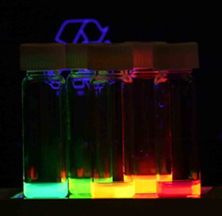
Back جهاز عرض النقطة الكمومية Arabic Pantalla de punts quàntics Catalan Quantenpunkt-Leuchtdiode German Pantalla de puntos cuánticos Spanish Kvantpunktkuvar Estonian Kvanttipistenäyttö Finnish תצוגת נקודות קוונטיות HE QLED Italian 퀀텀닷 디스플레이 Korean Qled Dutch

A quantum dot display is a display device that uses quantum dots (QD), semiconductor nanocrystals which can produce pure monochromatic[a] red, green, and blue light. Photo-emissive quantum dot particles are used in LCD backlights or display color filters. Quantum dots are excited by the blue light from the display panel to emit pure basic colors, which reduces light losses and color crosstalk in color filters, improving display brightness and color gamut. Light travels through QD layer film and traditional RGB filters made from color pigments, or through QD filters with red/green QD color converters and blue passthrough. Although the QD color filter technology is primarily used in LED-backlit LCDs, it is applicable to other display technologies which use color filters, such as blue/UV active-matrix organic light-emitting diode (AMOLED) or QNED/MicroLED display panels.[1][2][3] LED-backlit LCDs are the main application of photo-emissive quantum dots, though blue organic light-emitting diode (OLED) panels with QD color filters are now coming to market.[4]
Electro-emissive or electroluminescent quantum dot displays are an experimental type of display based on quantum-dot light-emitting diodes (QD-LED; also EL-QLED, ELQD, QDEL). These displays are similar to AMOLED and MicroLED displays, in that light would be produced directly in each pixel by applying electric current to inorganic nano-particles. Manufacturers asserted that QD-LED displays could support large, flexible displays and would not degrade as readily as OLEDs, making them good candidates for flat-panel TV screens, digital cameras, mobile phones and handheld game consoles.[5][6][7]
As of June 2016,[update] all commercial products, such as LCD TVs branded as QLED, employ quantum dots as photo-emissive particles; electro-emissive QD-LED TVs exist in laboratories only.[8][9]
In 2023, quantum dot technology was introduced into the commercial Mini/MicroLED display market, with pixel pitches of approximately 1.25 mm. By replacing conventional AlInGaP-based red light-emitting chips—which differ in material composition from green and blue InGaN chips—with quantum dot-converted red subpixels, Quantum Dot Chip-on-Board (QD-COB) displays demonstrated improved color consistency across a range of viewing angles.[10][11]
Quantum dot displays are capable of displaying wider color gamuts, with some devices approaching full coverage of the BT.2020 color gamut.[12][13][14] QD-OLED and QD-LED displays can achieve the same contrast as OLED/MicroLED displays with "perfect" black levels in the off state, unlike LED-backlit LCDs.
By the early 2020s, quantum dot (QD) color conversion began to be applied in MicroLED microdisplays to achieve full-color output.[15][16] MicroLED microdisplays—commonly used in near-eye devices such as augmented reality (AR) glasses and micro projectors—typically measure under 0.3 inches in diagonal and feature pixel pitches below 10 µm. At this scale, conventional mass transfer of discrete red, green, and blue microLEDs is technically challenging and cost-prohibitive. Instead, full color is achieved by starting with a blue microLED array and applying quantum dot layers to down-convert portions of the emission to red and green. Two main QD color conversion technologies have emerged: one embeds quantum dots in nanoporous GaN on blue LEDs (e.g., Nanopore Quantum Dot, or NPQD), and the other uses patterned quantum dot photoresist layers over the microLED array. [17][18] These approaches enable extremely high pixel densities and sufficient brightness for compact full-color displays—for example, QD photoresist has been used in a 0.22-inch display at over 7,000 PPI, reaching brightness levels above 150,000 nits. Additional experimental methods, such as inkjet printing of QD inks, are also under investigation for micron-scale integration.
Cite error: There are <ref group=lower-alpha> tags or {{efn}} templates on this page, but the references will not show without a {{reflist|group=lower-alpha}} template or {{notelist}} template (see the help page).
- ^ Mu-Hyun, Cho. "Samsung researching quantum dot on MicroLED TVs". ZDNet.
- ^ "StackPath". www.laserfocusworld.com. 8 January 2019.
- ^ "Quantum Dots to Shrink MicroLED Display Pixels". EETimes. 11 January 2019.
- ^ "Sony Bravia XR A95L QD-OLED TV review". 9 November 2023.
- ^ Quantum-dot displays could outshine their rivals, New Scientist, 10 December 2007
- ^ "Quantum Dot Electroluminescence". evidenttech.com. Archived from the original on 16 December 2009. Retrieved 3 April 2018.
- ^ Bullis, Kevin (1 May 2006). "Nanocrystal Displays". MIT Technology Review. Retrieved 3 April 2018.
- ^ www.etnews.com (18 October 2016). "Next Samsung Electronics' QLED TV's Name to Be SUHD QLED TV". etnews.com. Retrieved 3 April 2018.
- ^ "How QLED TV could help Samsung finally beat LG's OLEDs". cnet.com. 30 June 2016. Retrieved 3 April 2018.
- ^ "Leyard starts producing MicroLED displays with Saphlux's QD color conversion tech". microled-info.com. 12 October 2013. Retrieved 3 April 2025.
- ^ "Quantum Dot Displays Enter the COB 2.0 Era with Saphlux Technology". minimicroled.com. 27 February 2024. Retrieved 3 April 2025.
- ^ Society for Information Display, Digest of Technical Papers (9 April 2019). "Next-Generation Display Technology: Quantum-Dot LEDs". doi:10.1002/sdtp.10276.
{{cite journal}}: Cite journal requires|journal=(help) - ^ Cite error: The named reference
creol_rec2020was invoked but never defined (see the help page). - ^ Cite error: The named reference
bul3was invoked but never defined (see the help page). - ^ "Saphlux Unveils Revolutionary Full-Color NPQD® Microdisplay for AR/VR Headsets". businesswire.com. 17 August 2023. Retrieved 3 April 2025.
- ^ "MicroLED Display Advancements and the Rise of NPQD Technology". ledinside.com. 27 March 2025. Retrieved 3 April 2025.
- ^ Song, Jie; Chen, Chen (January 2021). "Nano-porous GaN enhances microLEDs". Compound Semiconductor Magazine. 27: 36–39.
- ^ Wu, Tingzhu; Huang, Yu-Ming; Konthoujam, James Singh; Chen, Zhong; Kuo, Hao-Chung (2021). Jiang, Hongxing; Lin, Jingyu (eds.). "Chapter Five - Quantum-dot-based full-color micro-LED displays". Semiconductors and Semimetals. 106: 173–201. doi:10.1016/bs.semsem.2021.01.005. ISBN 9780128230411. ISSN 0080-8784.
© MMXXIII Rich X Search. We shall prevail. All rights reserved. Rich X Search